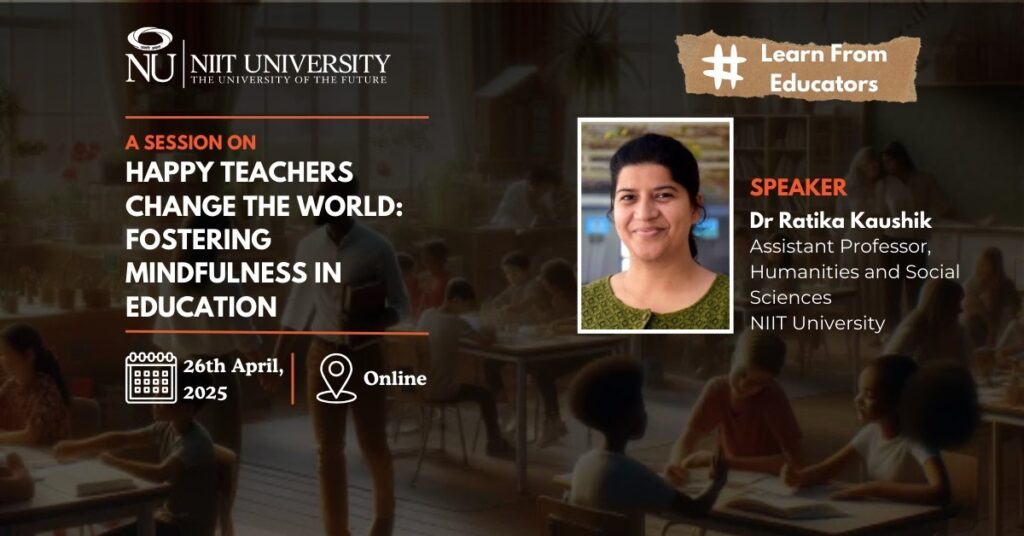Watch us in portrait mode to discover what makes us different.

In a motivating session that left students and faculty members equally thrilled, Dr Ratika Kaushik, Assistant Professor, Humanities and Social Sciences at NIIT University, presented a groundbreaking and hour-of-need idea—Happy Teachers Change the World. Drawing inspiration from the eponymous book by Zen master Thich Nhat Hanh and educator Katherine Weare, Dr. Kaushik drew on her own experiences, philosophical insights, and a challenge to teachers to bring classrooms together as spaces of joy, equanimity, and mindfulness.
Dr. Kaushik started by looking inwardly at her own student experience. At a school career counselling session, a seemingly potent question—Where do you see yourself in five years?—took her not to a job description, but to an epiphany: “I want to be happy.” That, she said, was both the culmination and the summary of her life’s purpose.
Even when told that happiness was not a “career goal,” she pleaded its case. She knew then, naturally, that real success isn’t what we do so much as how we feel when doing it. That insight, if naive and inexperienced at the time, was the basis for her theory of education,
Dr. Kaushik emphasized that joy is not small—it’s life-altering. A contented teacher, she explained, is not just a smiley face but an element not to be trifled with who can energize, inspire, and shape minds. The joy a teacher conveys in the classroom is not just felt but passed on, taken in, and passed along by students.
“Happy teachers create a happy, happy, happy classroom. A little happiness that they bring to your students in class is required.”
Despite the solemn task of helping shape teachers for tomorrow, she reminded the room that laughter and smiles are not distractions to learning—they are motivators.
The big message of Happy Teachers Change the World is bringing mindfulness into the classroom. Dr. Kaushik assumes that mental health and education cannot be mutually exclusive. Instead, they are incredibly intertwined. Because students tend to appear distracted, disconnected, and overwhelmed in the world today—especially after COVID—teachers must become islands of emotional presence and equanimity.
“We love our students every day. Why are they tuning us out? Why do they blankly scroll on their phones? Maybe it is time we transformed how we come into the classroom.”
She reinforced that mindfulness isn’t about heroic gestures. It’s about presence—pausing for a moment before entering a classroom, sitting and listening to oneself before anything else, and creating a tone of calm and connection. That simple gesture has a deep impact on students’ intellectual and emotional engagement.
Dr. Kaushik shattered the illusion that success is all about performance and output. She rather painted the picture of education as a deeply human, sustainable pursuit. As she said, the real agenda is not another doctor, engineer, or bureaucrat, but creating sane, fulfilled, happy individuals who can lead good, long lives.
“If we do not develop balanced minds, what are we constructing—another brick in the wall?”
Through the creation of awareness and sharing happiness, the students can be made not exhausted in the rat race but with the promise of leading worthy and productive lives.
Released in 2017, Happy Teachers Change the World is a book and so much more—a contemplative guidebook for teachers of any grade. Authored by Thich Nhat Hanh and Katherine Weare, it’s a blend of Buddhist philosophy and classroom-tested techniques for teachers. Step-by-step reflection and exercises, from how teachers prepare mentally to teach to how teachers build relationships with students in the classroom, are outlined in the book.
Dr. Kaushik invited us all to read the book—not just for professional development, but for health.
We ended our session with a reflection: happiness is contagious. A joyful teacher has the power to transform not just a classroom, but an entire school. With every laugh we provide, every sympathetic conversation, every thoughtful pause, we send out ripples of good change.
And perhaps that is the best lesson of all—that happy teachers do change the world.